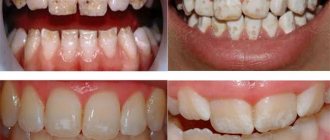The treatment tactics for caries depend on the cause of the pathological process and its neglect. This is the most common dental disease, characterized by gradual tooth decay. The pathology goes through several successive stages; at first, the patient may not feel anything; in complex cases, complete loss of dental units is possible.
It is not difficult to detect the disease, because most of the symptoms are quite obvious. However, it is better to prevent the occurrence of carious lesions by following preventive recommendations, and then a snow-white smile will delight you for many years.
What types of caries are there?
There are several stages of the disease. They have a certain appearance and symptoms.
How to determine the stage of caries:
- In the spot stage: a white spot is observed on the surface of the enamel (focus of demineralization). The spot gradually turns brown. Enamel is the densest tissue in the human body, but due to various cariogenic factors it is gradually destroyed. Detecting the white spot is quite difficult.
- Medium caries: characterized by damage to the enamel-dentin junction in the form of a cavity, short-term sensitivity.
- Deep: extensive lesion affecting the deep layers of dentin. Pain appears from different types of irritants: mechanical, temperature, chemical.
Diagnosis of the disease is carried out using a visual examination and an x-ray. The image will show violations of the integrity of the enamel and dentin with uneven contours.
Treatment with preparation of hard tooth tissues
This method is based on hardware treatment of the affected areas of the tooth under anesthesia. Depending on the stage of development of the disease, there are several stages in treatment. For average caries it is:
- anesthesia
- mechanical and medicinal treatment of canals
- installation of protective lining
- filling taking into account the dental characteristics of the tooth
- grinding and polishing of tooth surfaces
Medium and deep stage treatment takes an hour on average, but in some cases it takes longer. To treat average caries, one visit is enough.
The effect of treatment procedures is determined by the professionalism of the doctor, the quality of medications and equipment, and the individual characteristics of the patient’s body. The key to maintaining the result is compliance with proper nutrition and hygiene rules, as well as maintaining the protective functions of the body.
What does caries look like on teeth?
Not all patients know how to identify dental caries. To do this, you need to come to the dentist for an examination.
Black cavities of varying sizes are found on the chewing units. The pathological process develops in the natural depressions of the enamel: fissures, pits.
This disease leads to the destruction of hard tissues and cosmetic defects. There are black cavities on the front teeth, noticeable when talking or smiling:
Symptoms
The rate of growth of signs primarily depends on why caries occurs, holes are formed, and the inflammatory process develops in the neurovascular bundle. The most common symptoms of carious lesions:
- darkening of the enamel, the appearance of dots or stripes of a white or dark shade on it (typical of the initial stage);
- increased sensitivity when consuming certain categories of foods (sour, sweet, hot, cold, hard); pain when pressing on the diseased area or in the absence of mechanical action;
- deep black holes, cracks in hard tissues;
- bad breath;
- headache, shooting sensation in the ears.
Diagnosis of dental caries
In some cases, the patient can independently diagnose himself, based on characteristic signs such as the presence of black holes and pain. However, there are situations when only a competent specialist can detect a lesion. This applies to the initial stage of the pathology in the absence of severe symptoms. At later stages, a thorough examination is also important in order to correctly differentiate the pathological process from other disorders.
The main methods used in dentistry:
- visual inspection using a mirror and other tools;
- computer images (panoramic, radiovisiography, CT, 3D study);
- functional diagnostics;
- thermal test;
- probing.
Dentik uses modern X-ray machines with safe radiation exposure and other equipment. We examine adult patients, women during pregnancy and lactation, and small children.
How does caries form?
The causes of caries are poor hygiene and the presence of bacteria in the oral cavity.
There are many bacteria in the human oral cavity. These bacteria feed on food debris that remains on the surface of the enamel after eating. Bacteria “love” foods high in carbohydrates: sweets, flour. During their life, bacteria produce acid, which destroys teeth.
Caries occurs in both adults and children. This disease spreads in each person at a different rate.
Factors contributing to the rapid development of caries:
- insufficient or lack of oral hygiene;
- excess carbohydrate foods: flour products, sweets, carbonated drinks;
- low buffering capacity of saliva, when acids and alkalis are not sufficiently neutralized in the oral cavity;
- insufficient fluorine and calcium content in enamel;
- lack of vitamins and minerals in the body;
- severe somatic pathologies suffered in childhood (tuberculosis, rickets);
- reduced immunity.
Answering a frequent question from patients: “Why do caries form on teeth?”, we note that the most important factor is insufficient hygiene. All dentists strongly recommend brushing your teeth regularly and using floss to clean the gaps. Without careful hygiene, bacteria will destroy teeth one by one, leading to serious complications.
Symptoms of the disease
Initially, the disease is practically asymptomatic. During this period, a barely noticeable white or brown spot appears on the tooth. This is the first sign of superficial destruction of the enamel, but its integrity has not yet been compromised. Later, a carious cavity appears at the site where the spots formed.
If unpleasant sensations appear during the process of eating, and at the end of the chewing process they disappear, this indicates the presence of a carious process. If the pain does not disappear after the end of exposure to the irritant (food, liquid), perhaps the first stage of caries has ended and pulpitis has begun.
In some cases, the onset of the disease may be indicated by an unpleasant odor from the mouth.
To establish an accurate diagnosis, you need to visit a dentist.
What happens if caries is not treated?
- For a long time, the disease may not bother the patient in any way. When the destruction of hard tissue has reached a significant extent, sensitivity appears during eating.
- If you do not consult a doctor at the first stage, the carious process will go further and reach the pulp (nerve). Spontaneous severe pain appears. Treatment of pulpitis will be required.
- If the patient does not seek help at this stage, the infection spreads beyond the root. Periodontitis occurs. The prognosis here is unfavorable, since such a tooth often needs to be removed to eliminate the infection.
Therefore, timely visit to the dental clinic will help to avoid acute pain and complications.
Some additional facts
Just like that, after some time, the fillings do not need to be changed. The filling may remain with you for the rest of your life. Reason for replacement: breakage of a filling or tooth, as well as caries arising from the filling.
Minor caries is asymptomatic. By waiting for pain to appear, you are dooming yourself to more expensive and complex treatment.
In the treated tooth, caries stops. It may return after a while if the filling comes off and bacteria begin to penetrate into the resulting space between the filling and the tooth.
Often, caries occurs in places that are difficult to reach with a brush, for example, in the interdental spaces. That's why we strongly advise you to use dental floss.
Any cracks in teeth or fragments of teeth are at risk.
Not all tooth sensitivity indicates tooth decay. It can be caused, for example, by gum disease, which exposes the root of the tooth. In any case, only a doctor can name the reason.
When caries is detected in primary teeth, it is recommended to treat them, if possible, rather than remove them. After all, baby teeth save space for molars. In the absence of primary teeth, molars may be positioned incorrectly.
What to do if caries appears on teeth
First of all, you need to immediately contact your dentist. When a tooth is destroyed due to caries, treatment cannot be delayed. Otherwise, the complications described above arise. It is worth noting that no available means at home will relieve the patient of this problem. Only a dentist can cure this disease.
You should also pay attention to your oral hygiene:
- Brush your teeth at least twice a day.
- Use floss and mouth rinses.
- Visit your dentist for a checkup every six months.
- Come for professional hygiene every 6 months.
Dentists will help you select individual hygiene products (brushes, pastes, threads, rinses) at your appointment. The doctor will also determine why dental caries appears in your particular case and give the necessary recommendations.
Clinical researches
Asept toothpastes are distinguished by their clinically proven effectiveness - the products have been repeatedly tested. As part of the tests, it was found that:
- regular use of preventive toothpaste ASEPTA ACTIVE for a month can reduce bleeding gums by 60%, improve the overall condition of the oral cavity by 44% and reduce inflammation by 33% (research);
- Regular use of preventive toothpaste ASEPTA SENSITIVE for a month can reduce bleeding gums by 62%, reduce sensitivity of teeth and gums by 48% and reduce inflammation by 66%. (study);
- regular use of professional toothpaste ASEPTA REMINERALIZATION after 4 weeks improved the condition of the enamel by 64% and reduced tooth sensitivity by 66% (study);
- Regular use of professional toothpaste ASEPTA GENTLE WHITENING for a month allows you to lighten tooth enamel by 1.5 tones, increases anti-caries effectiveness by 3.4 times and increases enamel remineralization by 2.6 times (research).
Sources:
- Report on determining/confirming the preventive properties of toothpaste “ASEPTA PLUS” GENTLE WHITENING” Author: doctor-researcher A.A. Leontyev, head Department of Preventive Dentistry, Doctor of Medical Sciences, Professor S.B. Ulitovsky First St. Petersburg State Medical University named after. acad. I.P. Pavlova, Department of Preventive Dentistry
- Clinical and laboratory assessment of the influence of domestic therapeutic and prophylactic toothpaste based on plant extracts on the condition of the oral cavity in patients with simple marginal gingivitis. Doctor of Medical Sciences, Professor Elovikova T.M.1, Candidate of Chemical Sciences, Associate Professor Ermishina E.Yu. 2, Doctor of Technical Sciences Associate Professor Belokonova N.A. 2 Department of Therapeutic Dentistry USMU1, Department of General Chemistry USMU2
- Report on the determination/confirmation of the preventive properties of personal oral hygiene products “ASEPTA PLUS” Remineralization doctor-researcher A.A. Leontyev, head Department of Preventive Dentistry, Doctor of Medical Sciences, Professor S.B. Ulitovsky First St. Petersburg State Medical University named after. acad. I.P. Pavlova, Department of Preventive Dentistry
- Clinical studies of antisensitive toothpaste “Asepta Sensitive” (A.A. Leontyev, O.V. Kalinina, S.B. Ulitovsky) A.A. LEONTIEV, dentist O.V. KALININA, dentist S.B. ULITOVSKY, Doctor of Medical Sciences, Prof. Department of Therapeutic Dentistry, St. Petersburg State Medical University named after. acad. I.P. Pavlova
- The role of anti-inflammatory rinse in the treatment of periodontal diseases (L.Yu. Orekhova, A.A. Leontyev, S.B. Ulitovsky) L.Yu. OREKHOVA, Doctor of Medical Sciences, Prof., Head of Department; A.A. LEONTIEV, dentist; S.B. ULITOVSKY, Doctor of Medical Sciences, Prof. Department of Therapeutic Dentistry of St. Petersburg State Medical University named after. acad. I. P. Pavlova
- Report on determining/confirming the preventive properties of toothpaste “ASEPTA PLUS” COFFEE and TOBACCO Author: doctor-researcher A.A. Leontyev, head Department of Preventive Dentistry, Doctor of Medical Sciences, Professor S.B. Ulitovsky. First St. Petersburg State Medical University named after. acad. I.P. Pavlova, Department of Preventive Dentistry
- Report on determining/confirming the preventive properties of commercially produced personal oral hygiene products: Asepta toothpaste used in combination with Asepta mouthwash and Asepta gum balm Head. Department of PFS Doctor of Medical Sciences Professor S.B. Ulitovsky St. Petersburg State Medical University named after Academician I.P. Pavlova. Faculty of Dentistry. Department of Preventive Dentistry.
How is caries treated?
The treatment is carried out in professional dentistry by a general practitioner and is absolutely painless. This treatment is carried out in one visit, and several teeth can be treated in one visit.
Sequence of treatment stages:
- Examination of the oral cavity. Carrying out diagnostics: a targeted diagnostic image of one tooth or computed tomography of the jaws (if multiple caries is detected during the examination). This is done in order to make an accurate diagnosis and see the volume of destroyed tissue.
- Local anesthesia: selected individually according to health conditions. Only after the desired area of the oral cavity has become numb does the doctor proceed to the next manipulations.
- Placement of isolation: the doctor places a rubber dam on the desired area - this is a latex plate that isolates the tooth from the rest of the oral cavity. The rubber dam creates comfortable conditions for the doctor, the patient, and also allows you to create dry, sterile conditions for placing a filling. This is necessary for the filling to serve for a long time and with high quality.
- Preparation of enamel, dentin: necrectomy. The doctor uses a drill to drill out the destroyed tissue.
- Treating the cavity with antiseptic solutions, applying an adhesive - a special solution that, like glue, reliably bonds hard tissue to the filling.
- Filling with light-curing materials. The anatomical shape of the tooth is restored, and the color is carefully selected.
- Polishing and grinding so that the filling does not feel different from your own teeth. Also, using special guidelines, the doctor checks whether the filling is too high or does not interfere with the normal closure of the jaws. Excess is removed, sharp edges are sanded.
- The doctor gives recommendations after treatment. If a tooth has been severely damaged by caries, then in addition to a filling, an orthopedic onlay or crown may be required. This is due to the fact that the filling is not as strong as enamel. Over time, cracks and chips are possible. Orthopedic structures will help protect the treated tooth from these complications.
After these stages, the tooth is completely free of caries. Next, you will need to maintain regular hygiene, come for preventive examinations and professional cleaning.









